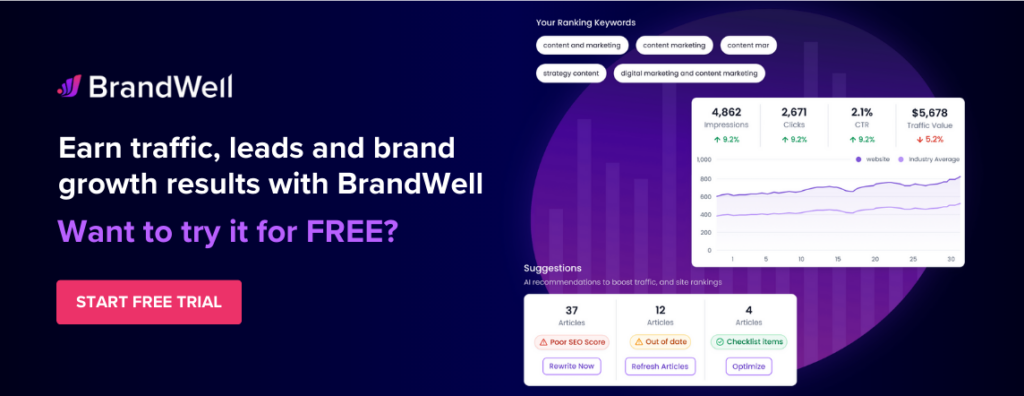Discover top guides, trends, tips and expertise from AIO Writers
When to Call, Email, or Text: Choosing the Right Outreach Based on Website Behavior
Ben Harper
Tuesday, 4th Feb 2025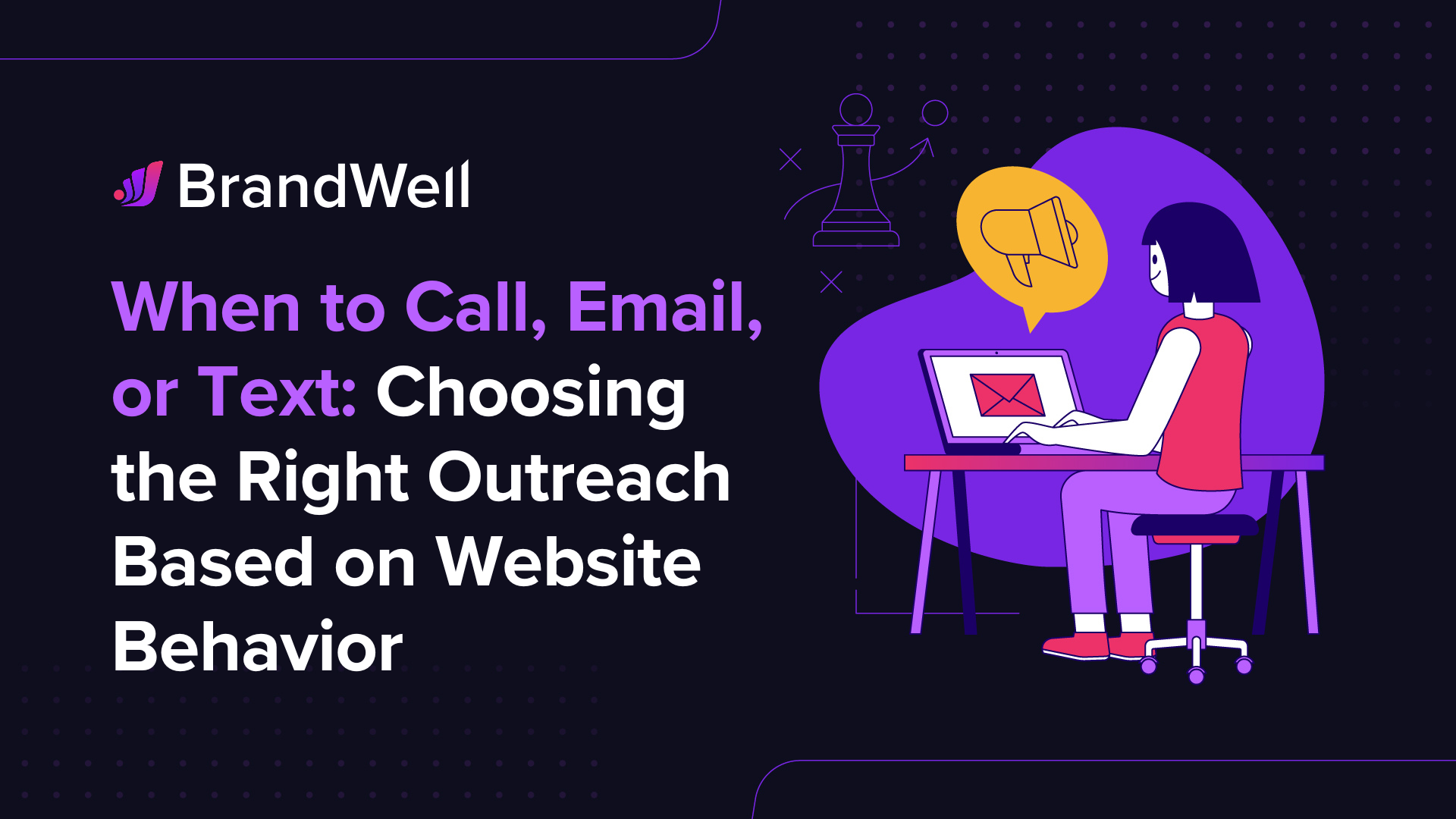
Cold calling can be an effective way to start a conversation but it can also feel intrusive.
On the other hand, cold emails are often seen as less disruptive, but it can be difficult to get a prospect’s attention amidst a crowded inbox.
So, how do you know when to pick up the phone, send an email, or even reach out by text when you’re trying to reach a lead?
The truth is, when it comes to B2B sales outreach, timing and context are everything. According to recent studies, the average cold email response rate hovers around 1-5%, but the success of a cold email can vary greatly depending on factors like industry, target audience, subject line, and the day and time you send it.
Meanwhile, cold calls can often result in higher engagement when a strong relationship is needed early on — particularly when reaching out to decision-makers like C-suite executives.
But what if you could determine the best time and channel for outreach based on website behavior?
A tool like TrafficID makes that possible.
By identifying who’s visiting your site and when, TrafficID can help you can make smarter decisions about how to engage — whether it’s with a quick email, a personal call, or even a timely text message.
In this post, we’ll dive into the pros and cons of cold calls, cold emails, and SMS and explore when it’s best to use each method based on the specific behavior of your website visitors.
We’ll also share tips on improving your cold outreach strategy and how TrafficID can help you personalize your approach, turning anonymous visitors into real connections.
Table Of Contents:
- Cold Call vs. Cold Email: The Pros and Cons
- Why Website Behavior Matters in Outreach
- Deciphering Website Behavior: Key Metrics
- When to Call vs. When to Email
- Text Messaging: A Growing Trend
- Choosing the Right Outreach Based on Website Behavior
- Tips on How to Improve Your Cold Outreach Efforts
- Turn Data into Deals with Smarter Outreach
Cold Call vs. Cold Email: The Pros and Cons
When deciding whether to make a cold call or send a cold email, it’s crucial to understand the strengths and weaknesses of each method. Both have their place in a successful sales outreach campaign, but knowing when to use each one can be the key to maximizing your outreach effectiveness.
Cold Calls: The Pros
Personalization
Cold calling allows for a more personal connection. Hearing a human voice on the other end can immediately break the ice and build rapport, something emails can’t always achieve.
According to the RAIN Group, 82% of buyers accept meetings from sellers who proactively reach out by phone. And 57% of C-level and VP buyers prefer to be contacted by phone.
When done correctly, cold calls can lead to genuine, productive conversations that might not happen through email.
Effective for Gathering Information
During a cold call, you can ask questions in real time, adjust your pitch based on the prospect’s responses, and gather key information about their needs. Unlike emails, where responses may take days, a cold call provides immediate feedback.
For example, if you’re speaking with a decision-maker, you can often learn whether they are the right person to talk to, or if there’s someone else in the organization you should be targeting.
Builds Urgency
Phone calls create a sense of urgency that emails often lack. The immediate nature of a call can push prospects to take action more quickly, especially if you can engage them with a compelling pitch at the right moment. It’s also easier to gauge their level of interest based on their tone, pace of speech, and willingness to continue the conversation.
Cold Calls: The Cons
Invasive and Disruptive
One of the biggest downsides of cold calling is that it can be perceived as disruptive. Unlike an email, which a prospect can open and read at their convenience, a phone call interrupts their day.
A huge majority of prospects view cold calls as an unwelcome disruption, with estimates often placing the percentage around 80% or higher. This negative impression can harm your brand’s reputation.
Limited Scalability
Cold calling is time-intensive, and there are only so many calls a sales rep can make in a day. This makes it less scalable than email outreach. Each call requires preparation, personalization, and real-time engagement, which can limit the number of prospects you can contact compared to sending a batch of emails.


Cold Emails: The Pros
Easier to Scale
On the other hand, cold emailing is far easier to scale. You can craft one message and send it to hundreds or even thousands of prospects at once, saving valuable time.
According to a survey conducted by the Data & Marketing Association, email marketing has a median ROI of 122%, more than four times higher than other marketing formats. This makes email a profitable option for businesses looking to expand their reach without significantly increasing resources.
Trackable and Measurable
Emails allow for advanced tracking, giving you clear data on open rates, click-through rates, and responses. This makes it easier to refine your outreach strategies and optimize for better results.
Tools like Mailchimp can help you monitor how your emails perform, allowing you to tweak your approach in real time. The visibility of this data makes cold emails easier to analyze and optimize for success.
Less Intrusive
With cold emails, recipients have complete control over when and if they respond. They can check emails during their designated breaks or at the end of the workday.
Recipients can also take their time to craft a response, ask questions, or even ignore the email altogether. Cold emails demonstrate respect for the recipient’s time as you allow them to prioritize their responses and manage their workload more efficiently.
Cold Emails: The Cons
Easier for Prospects to Ignore
While emails can be non-intrusive, they also make it easier for prospects to hit the “delete” button without giving your message a second thought. With dozens (or hundreds) of emails flooding their inbox, standing out can be a significant challenge.
Potentially Lower Engagement
While cold emails can be highly effective when done right, they often see lower engagement than cold calls. This can be especially true if you’re reaching out to high-level decision-makers who receive a high volume of emails daily.
Both cold calls and cold emails have their strengths and weaknesses. The decision of whether to call or email should depend on the specific context — like the behavior of the website visitor you’re reaching out to, their role within the company, and where they are in the buyer’s journey. Using tools like TrafficID can provide crucial insights into when a lead is engaging deeply with your site, making it easier to determine the best approach.
Why Website Behavior Matters in Outreach
Imagine walking into a room full of strangers and trying to strike up a conversation without knowing anything about them.
Awkward, right?
That’s exactly what cold calling or emailing feels like — it’s a shot in the dark.
Now, imagine instead that you’ve got a cheat sheet telling you who’s interested in what, what they’ve browsed, and how they’ve engaged with your content. That’s the power of website behavior insights.
When you know how a visitor interacts with your website — what pages they’ve viewed, how long they stayed, or whether they downloaded that whitepaper you posted — you’re no longer just guessing. You’re meeting them where they already are in their journey.
That’s outreach gold — one that you could unearth with an advanced visitor identification tool like TrafficiD.
Just look at the dearth of information you can dig up with TrafficID:
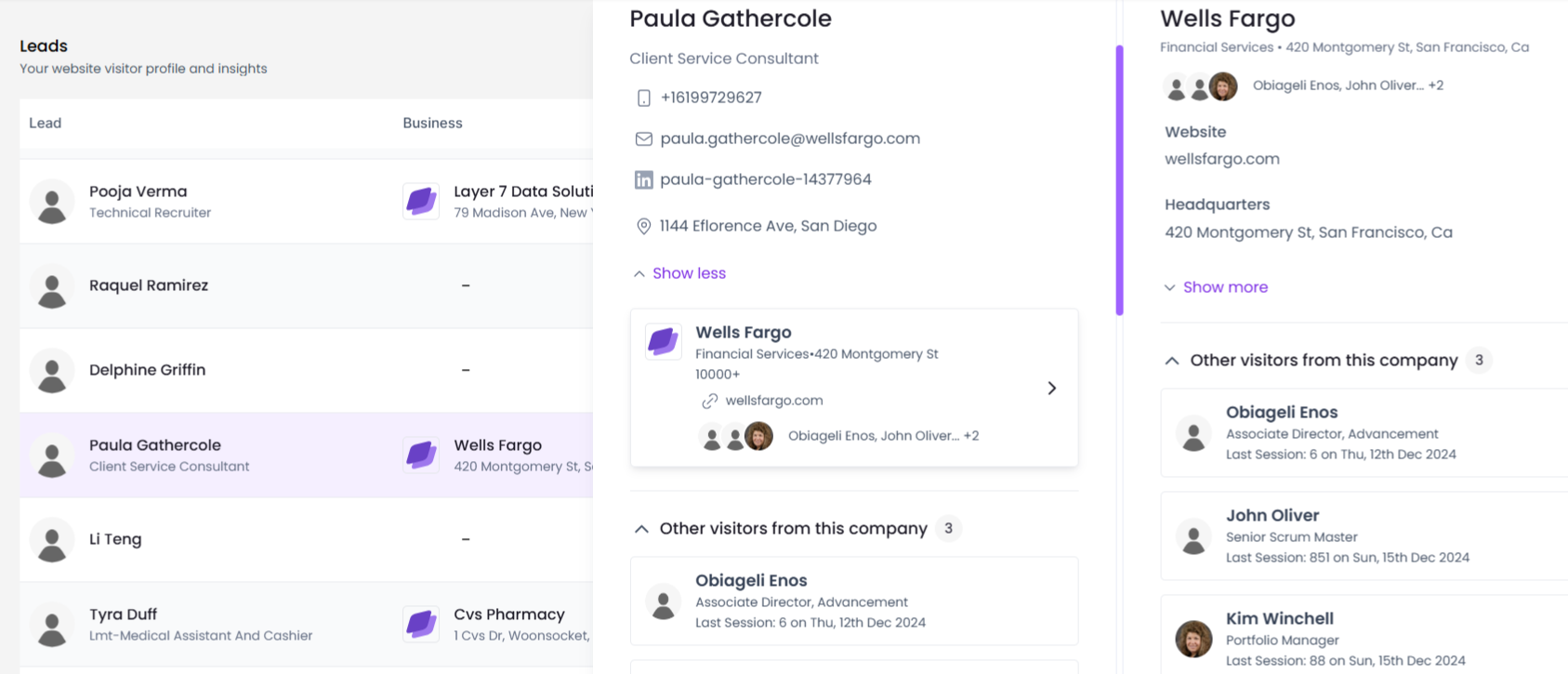

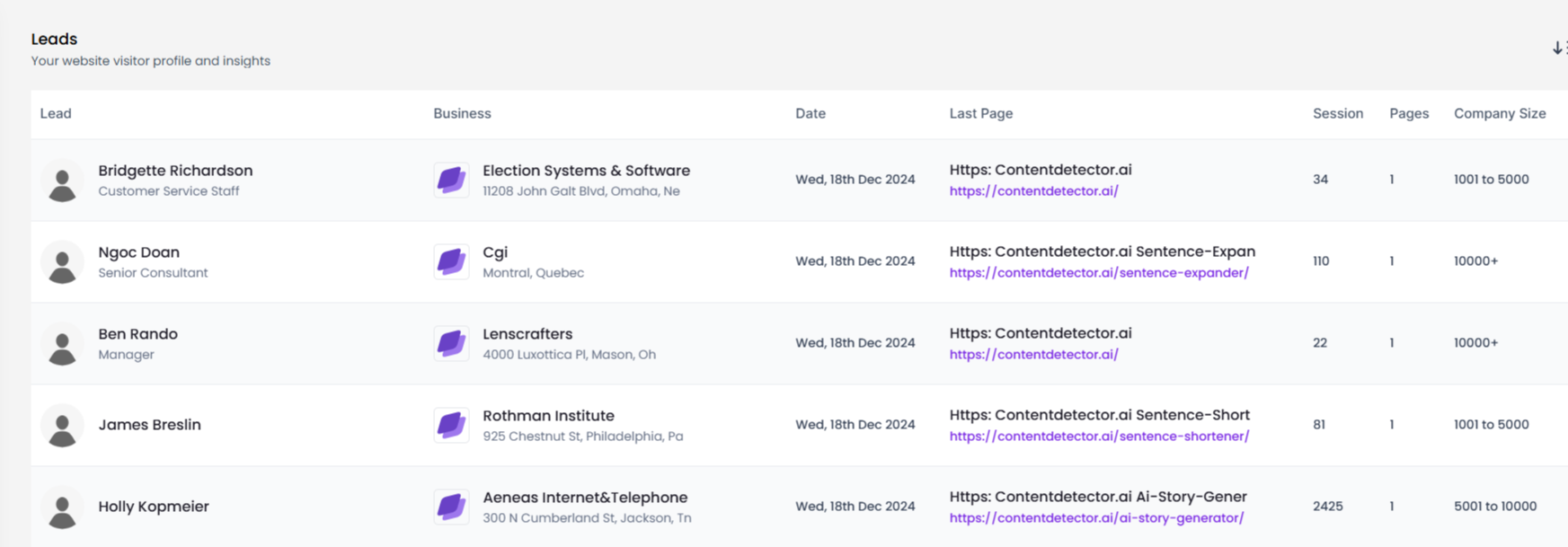

Here’s how TrafficID can help improve your outreach:
- Relevance is king: If someone has visited your pricing page three times this week, they’re signaling interest. When you reach out to them, you can skip the generic pitch and jump straight into addressing their needs.
- Better timing: Website behavior tells you when someone is actively considering your product or service. Reaching out while you’re top-of-mind increases the chances of a response.
- Building trust: Nobody likes feeling like just another name on a list. Referencing their interactions (“I noticed you’ve been exploring our case studies”) shows you’ve done your homework so it feels personal, not pushy.
- Efficient effort: Why waste time calling 100 people who may not care when you can focus on the 10 who’ve already shown interest? Website insights let you prioritize the hottest leads.
- Improved messaging: The more you know about your prospect’s behavior, the more tailored your message can be. It’s the difference between saying, “Check out our product” and “I saw you were interested in our lead generation tools — how can we help streamline your process?”
Cold outreach is a numbers game.
Outreach backed by visitor insights? That’s a strategy game — and you’ve got the upper hand.
With tools like Traffic ID, you’re no longer guessing who might be interested. You’re confidently connecting with people already raising their hands. That’s how you turn anonymous visitors into meaningful conversations.
Deciphering Website Behavior: Key Metrics
Certain website metrics are key for guiding outreach decisions. Let’s explore a few:
Page Views and Time on Page
High page views and time spent on particular pages show deep interest in those topics. These are warm leads and possibly justify a phone call for sales or support.
High page views also signal an email marketing opportunity. In B2B, high page views often come from successful email referrals.
Download History
Downloading resources reveals a desire to learn more. This provides clear topics to reference in email marketing, enhancing message value and relevance.
Video Engagement
Visitor interaction with a video shows that the content resonates. Adding videos to your sales outreach increases click rates.
People interacting with videos are visually oriented. If their data indicates a preference for certain industry-specific videos, consider using short, concise videos for future communications.
Video testimonials or brief explanations could also be effective. Use website behavior to refine your outreach strategy and boost your conversion rates.
Social Media Activity
Frequent shares and comments indicate social media engagement. These users are prime candidates for building deeper connections through personalized videos or interactive Q&A sessions on your social media channels.
This also creates an opening for valuable social-specific content within larger outreach campaigns.
When to Call vs. When to Email
Choosing between a cold call and a cold email is not always straightforward. Several factors influence the best approach, including timing, your client outreach objective, and the prospect’s role or preferences. Here’s a breakdown to help you decide.
1. Time and Day of the Week
Timing plays a crucial role in the success of your outreach marketing. Cold calls tend to be more effective during specific hours and days. Research suggests that the best times to make a cold call are between 10 a.m. and 11 a.m. and 2 p.m. and 3 p.m., as people are less likely to be tied up in meetings or tasks during these windows.
Tuesdays and Thursdays are often ideal for calls because they’re midweek days when people are more settled into their work rhythm.
For emails, however, Mondays and Wednesdays tend to perform better. Emails sent early in the morning (around 8 a.m.) or late in the afternoon (around 4 p.m.) are more likely to be opened as they bookend the busiest parts of the workday.
2. Outreach Objective
Your outreach goal significantly impacts whether a call or an email is better.
Strong Ask: If you’re asking for something immediate, like scheduling a meeting or closing a deal, picking up the phone is more effective. Cold calls create urgency and allow you to handle objections in real time.
Weak Ask: If your goal is softer, like introducing yourself or sharing information, emails work well. Emails let you provide detailed information that the prospect can review at their convenience.
3. Prospect Role
The decision-maker’s role in the company also dictates the best outreach method.
C-level Executives: These individuals are typically harder to reach by phone, and they may prefer email to manage their schedules more efficiently. However, if a C-suite executive is highly engaged (e.g., visiting pricing or demo pages), a well-timed call might stand out.
Mid-level or Customer-facing Roles: People in sales, customer service, or account management roles are often more open to phone calls, as their daily routines involve frequent conversations.
TrafficID lets you see a prospect’s role or job title right on the main dashboard:
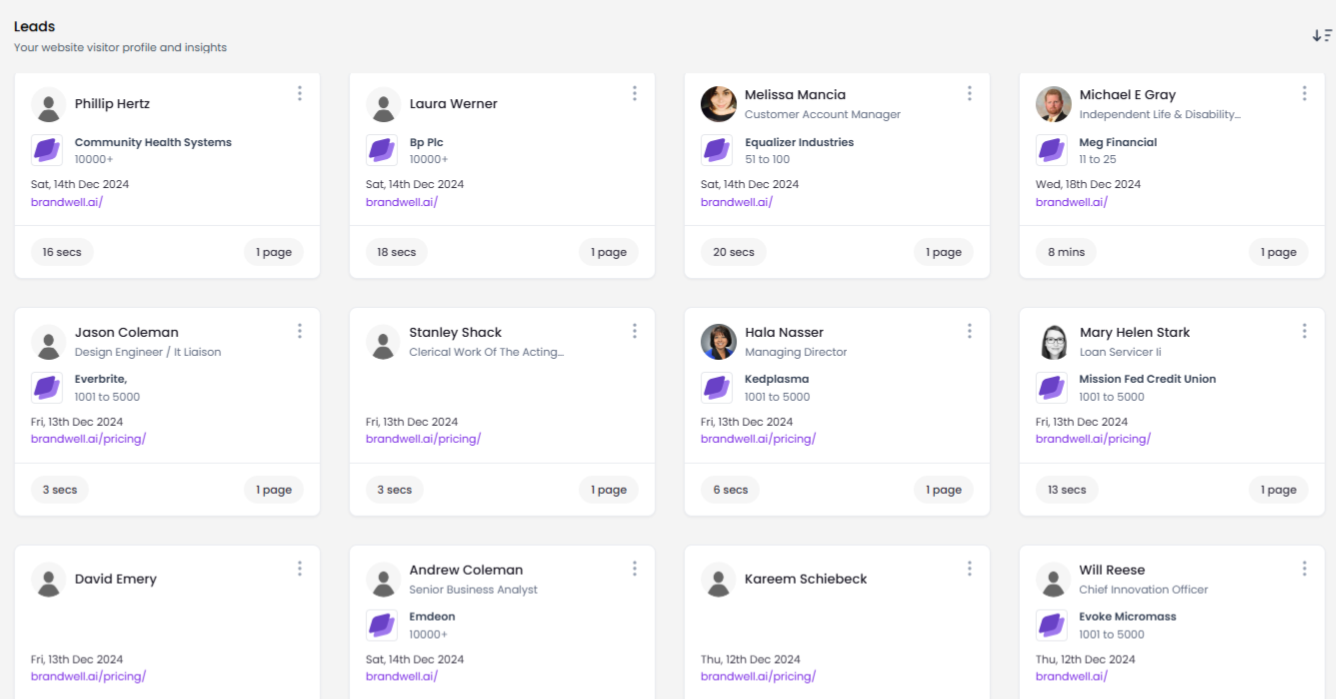

4. Buyer Persona Preferences
Demographics and behavioral preferences can also inform your approach.
Millennials and Gen Z: These groups are often more receptive to email or even social media outreach than phone calls. They value concise, actionable communication.
Baby Boomers and Gen X: These groups might be more comfortable with phone calls, especially if their roles involve direct interpersonal interaction.
Understanding your buyer persona helps align your method with their expectations and comfort levels.
5. Deal Status
Where the prospect is in the sales funnel should guide your outreach method.
Early Stages: For leads just starting their journey, emails are effective for nurturing and building awareness without pressuring the prospect.
Late Stages: When a prospect is closer to making a decision, a phone call can help solidify the relationship, address final objections, and close the deal.
Unresponsive Prospects: If a prospect has not responded to multiple emails, a phone call can grab their attention and reignite interest.
Clicking on a visitor profile on the TrafficID dashboard takes you to more detailed insights like deal stage and other people from the company visiting your website.
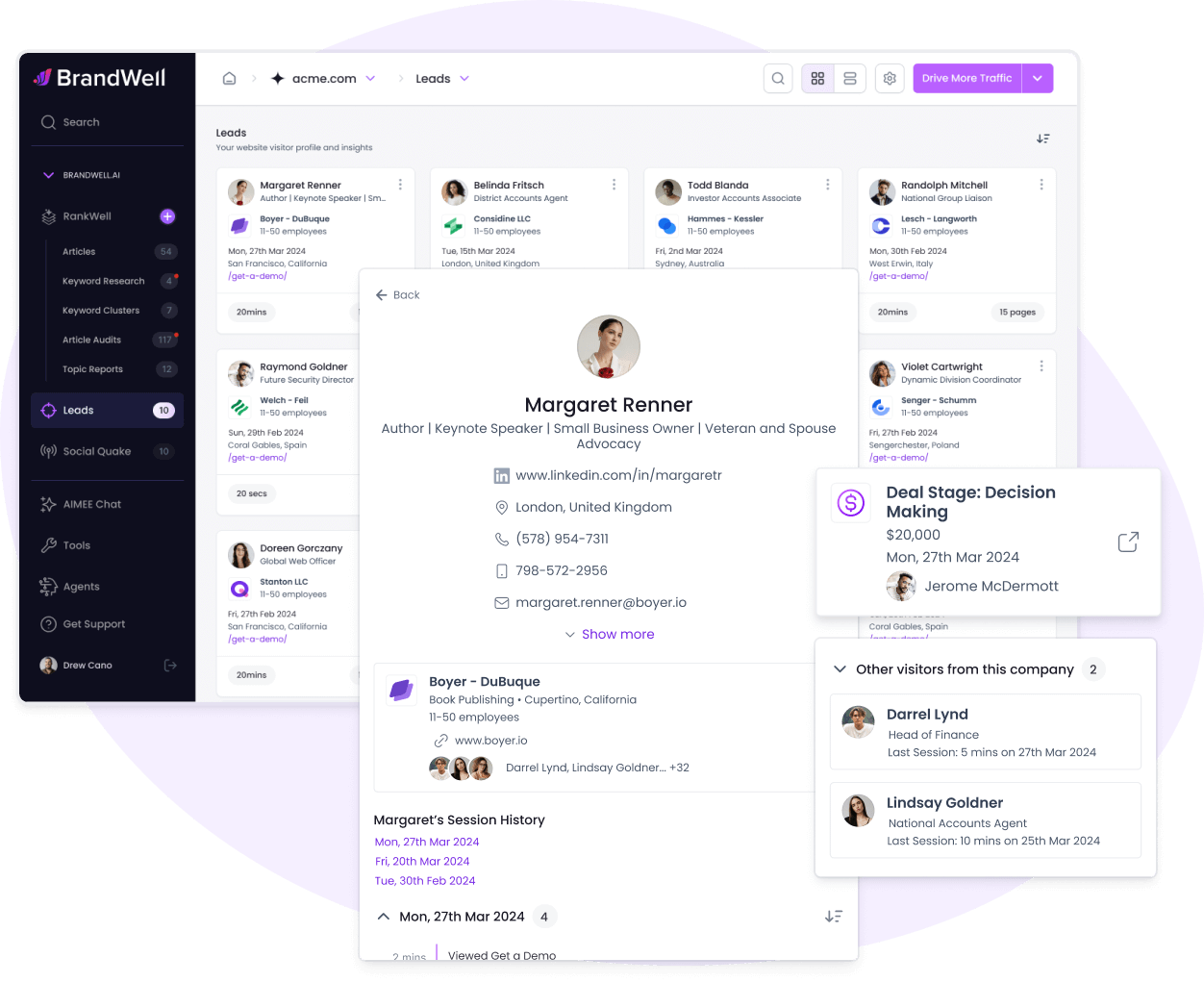

Start creating effective email campaigns based on lead data.
Text Messaging: A Growing Trend
Text messaging is rapidly becoming a viable outreach channel for B2B sales teams, marketing agencies, and business owners. With 91% of consumers preferring to receive business communications via SMS and text messages boasting an impressive 98% open rate, it’s clear why this method is gaining traction.
However, text messaging must be used strategically to avoid crossing boundaries.
When Texting Works Best
Immediate Follow-Up After an Interaction
If a prospect has recently engaged with your brand — such as attending a webinar, filling out a form, or downloading a resource — texting can provide a personal and immediate way to follow up.
For example:
“Hi Alex, thanks for attending our webinar on lead generation strategies! Let me know if you’d like to schedule a quick call to discuss how TrafficID can help you.”
Appointment Reminders and Confirmations
For prospects who have already scheduled a meeting or demo, a text message reminder can ensure attendance and reduce no-shows. Studies show that reminder texts can increase attendance rates by up to 30%.
Urgent Notifications or Time-Sensitive Offers
Texts are ideal for conveying urgency, such as limited-time offers or event registrations nearing capacity. The immediacy of text messaging ensures that prospects see the message quickly and can act faster.
Post-Call or Meeting Engagement
A quick text after a call or meeting to share a summary, thank the prospect, or provide a direct link to resources creates a strong personal connection and keeps the conversation alive.
Pros of Text Messaging
- High Engagement Rates: Texts are read almost instantly, with most recipients opening messages within three minutes.
- Personalized Communication: Texts feel more personal and direct, fostering stronger connections.
- Convenience: Prospects can respond at their convenience, reducing the pressure of real-time interaction.
Cons of Text Messaging
- Invasiveness: Texting can feel intrusive if not used appropriately or without prior consent.
- Limited Messaging Space: With character limits, complex messages or detailed information may not translate well.
- Compliance Challenges: Texting requires adherence to strict opt-in laws like the TCPA (Telephone Consumer Protection Act) to avoid legal issues.
Choosing the Right Outreach Based on Website Behavior
One thing that can help you choose the right client outreach method is analyzing the behavior of your lead on your website.
For example, a lead who has visited your case studies and pricing pages may warrant a phone call due to their apparent interest. Conversely, a lead who browsed your blog briefly might be better served with a follow-up email.
Tools like TrafficID can provide insights to help you determine:
Passive Browsers
These individuals browse pages without deeper interaction. Nurture passive interest with helpful emails, like a blog post or targeted video, to move them down the sales funnel.
Since most sales require multiple follow-ups, plan long-term campaigns. Use personalized subject lines and consider their past website activity to create highly targeted emails.
Learn more about personalizing outreach to turn anonymous leads into real customers.
Active Researchers
Users spending significant time on detailed content and downloading resources show serious engagement. Offer a complimentary consultation or valuable insight in a preferred format.
In-person requests can be very effective for these potential clients.
Sharing is promoting. Frequent LinkedIn comments suggest strong platform affinity. Engage these users with collaborative discussion instead of direct sales pitches. Invite them for a real-time chat.
Visual outreach, like high-quality photos or short videos, can be impactful. Consider asking for testimonials or product reviews.
Instead of pushing sales, nurture referral opportunities through email sequences highlighting new content. These prospects are busy, so consider email as a primary outreach channel. Target your sales outreach based on customer behavior and pain points.
Consider how different customer segments interact with your content. If video content outperforms podcasts on social media, adjust your strategy accordingly. Focus your media marketing efforts on channels with higher engagement. Increase brand awareness and customer retention by creating meaningful connections.
Tips on How to Improve Your Cold Outreach Efforts
Cold outreach is a cornerstone of successful lead generation, but doing it effectively requires strategy and precision. Below are some actionable tips to improve your outreach efforts and how TrafficID makes the job easy.
1. Narrow Your Target Audience
Effective outreach starts with targeting the right prospects. Sending cold emails or calls to unqualified leads wastes time and resources.
TrafficID reveals detailed visitor information and behavioral data so instead of guessing, you can directly identify who is already interested in your offerings and tailor your outreach accordingly.
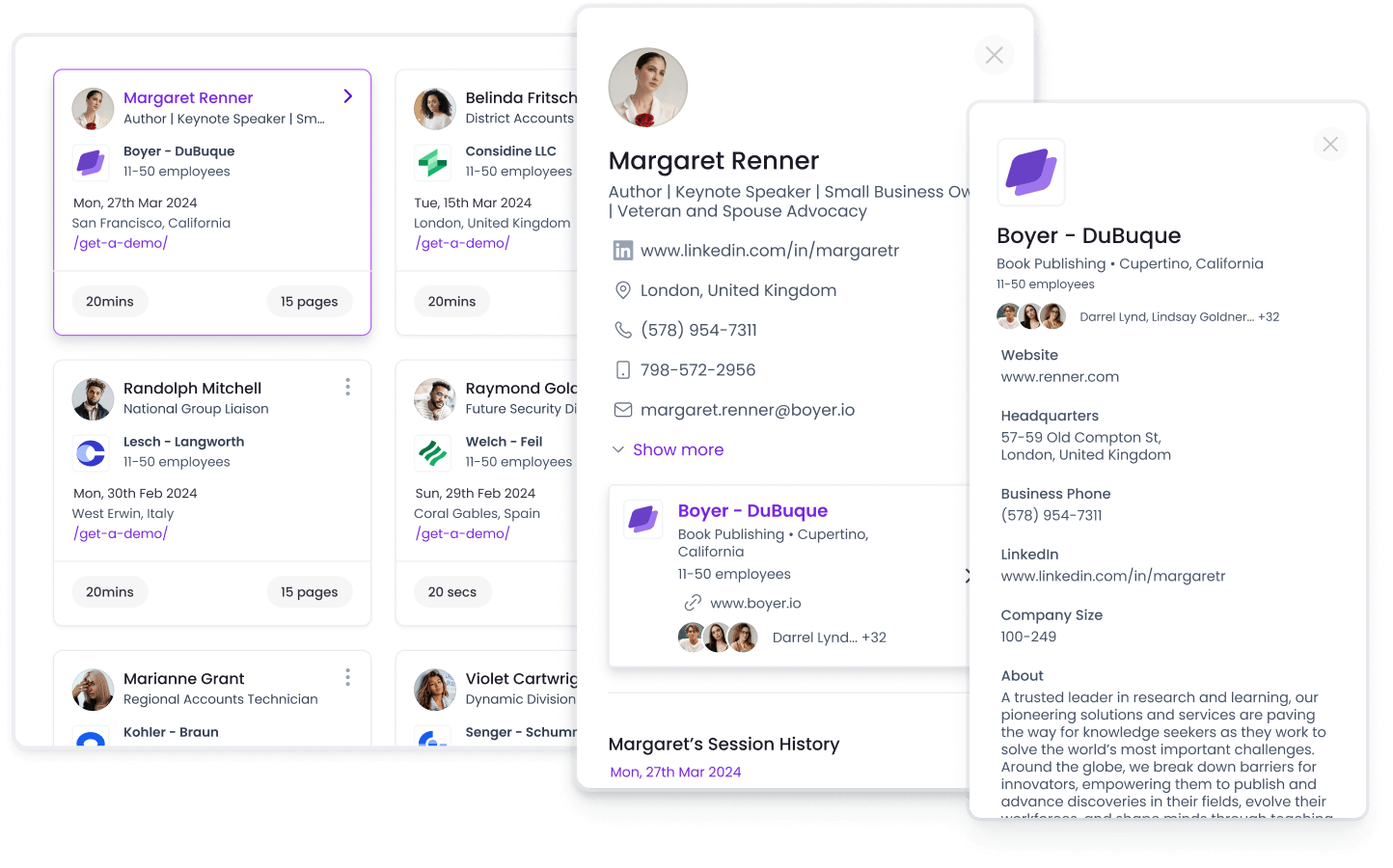

2. Get the Timing Right
Timing is everything in outreach. Studies show that reaching out within 5 minutes of a lead’s engagement has a 21 times higher conversion rate than calling them after 30 minutes.
TrafficID provides real-time alerts when prospects visit your site or specific pages, enabling your team to reach out at the peak of their interest.
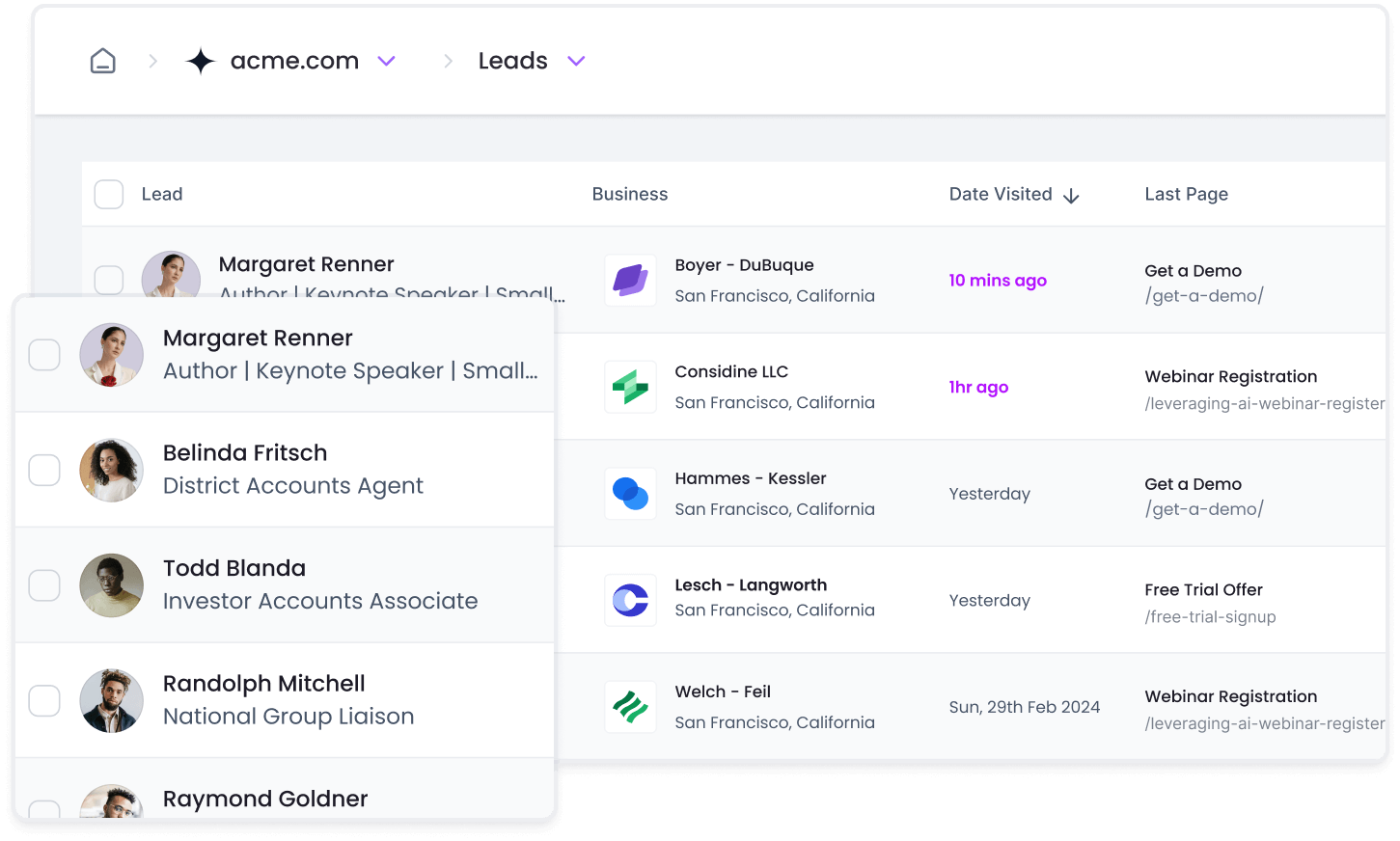

3. Personalize Every Interaction
Generic outreach is easy to ignore. Customizing messages based on the recipient’s industry, challenges, and recent activity makes your outreach stand out.
With insights into what pages a visitor explored, TrafficID can help you personalize your emails, calls, or texts with references to their interests.
For example:
“Hi Alex, I noticed you reviewed our pricing page — do you have questions about how TrafficID can fit your budget?”
Here’s a sample email written straight from TrafficID data:
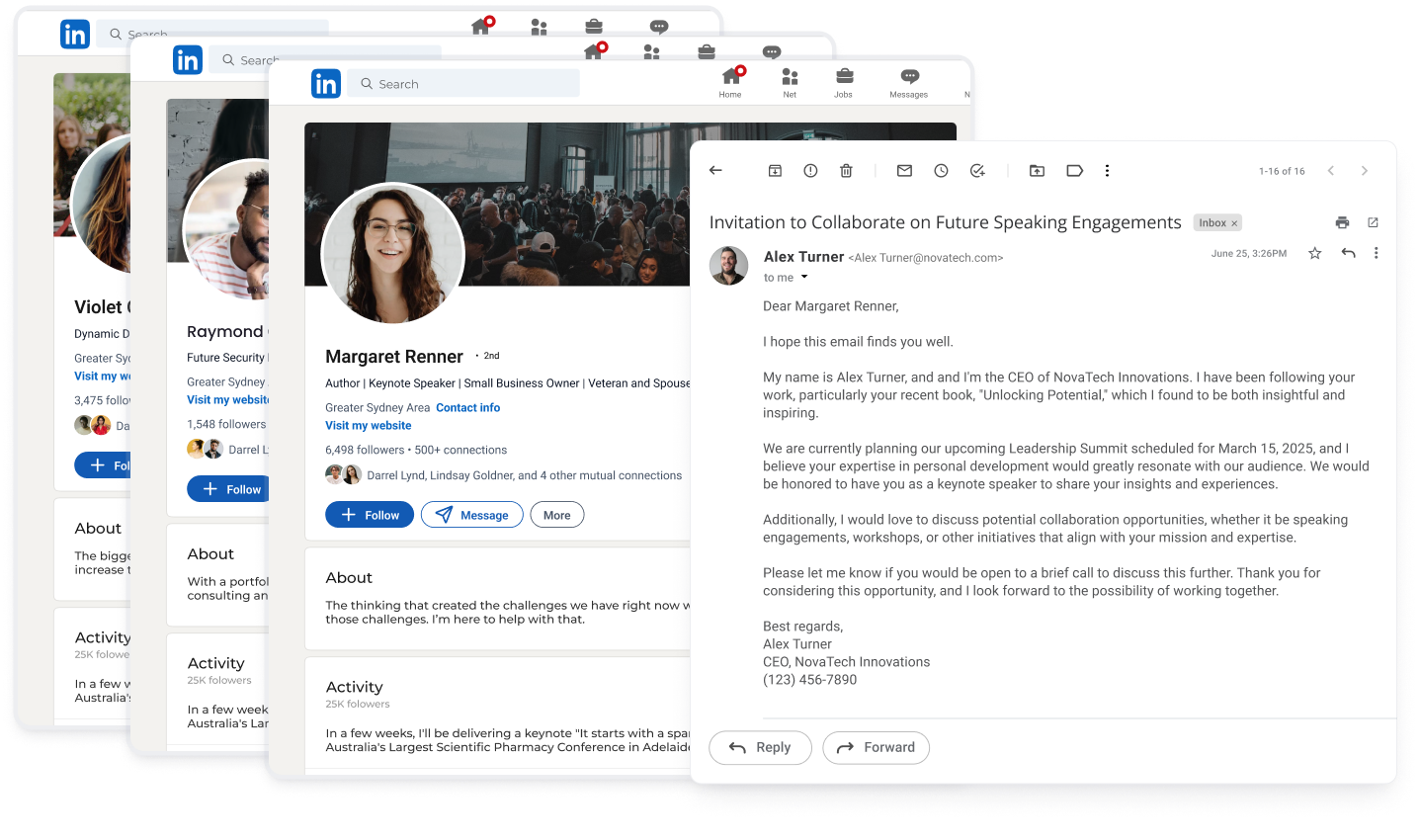

4. Write Compelling Subject Lines and Openers
Your email subject line or opening statement determines whether your message gets noticed. Use curiosity, urgency, or value propositions to engage prospects quickly.
For example:
Subject line: “We noticed your interest — here’s how we can help!”
Opener: “I see your team has been exploring solutions for lead generation…”
TrafficID gives you the context to create hyper-relevant subject lines and openings based on a lead’s behavior.
5. Eliminate Tedious Tasks with Automation
Automation tools can streamline repetitive tasks like follow-ups, email scheduling, and CRM updates, freeing up time for more meaningful interactions.
Integrations with platforms like Zapier and GoHighLevel allow Traffic ID users to automate lead workflows, ensuring your sales team focuses on high-value activities.
6. Focus on Active Listening During Calls
When on a call, prioritize understanding over pitching. Listen to the prospect’s needs, ask open-ended questions, and mirror their language to build rapport.
Example Questions:
“What challenges are you currently facing in lead generation?”
“What solutions have you considered so far?”
The behavioral data from TrafficID can guide your questions, helping you address the most relevant issues for the prospect.
7. Use Data-Driven Insights to Prioritize Leads
Not all leads are equal. Focus your energy on prospects who show strong buying signals, such as visiting high-intent pages like pricing or case studies.
With features like hot lead filters, Traffic ID enables you to identify and prioritize leads most likely to convert.
8. Follow Up Consistently and Strategically
According to Marketing Donut, 80% of sales leads require five follow-ups after the initial contact. However, only 8% of salespeople do follow up that many times.
- Alternate between email, calls, and texts.
- Wait 3 to 5 days before sending your first follow-up email.
- Space subsequent follow-ups 2 to 3 days apart.
- Adjust your timing based on the recipient’s responsiveness.
- Use email templates or call scripts to streamline your outreach efforts, but personalize them to make each message feel unique.
- Be empathetic and consider the recipient’s busy life.
- Always end with a powerful call to action (CTA).
TrafficID tracks repeat visits, letting you know when a lead re-engages, so you can time your follow-ups perfectly.
9. Leverage Multichannel Outreach
Don’t rely solely on one outreach marketing method. Combining email, calls, texts, social media, and retargeting ads increases your chances of reaching the prospect effectively.
TrafficID enables you to export leads for ad campaigns, allowing for highly targeted retargeting to complement your direct outreach efforts.
10. Test and Optimize Regularly
Lastly, your outreach strategy should evolve based on what works. Test different subject lines, email lengths, call scripts, and timing to refine your approach.
By integrating TrafficID into your cold outreach strategy, you gain a competitive edge through real-time insights, personalized data, and automation tools. Instead of wasting time on generic, untargeted outreach, Traffic ID empowers your team to act on warm leads, tailor messaging, and close deals faster.
Mastering cold outreach is about strategy, timing, and relevance — and Traffic ID ensures you have all three at your fingertips.
Turn Data into Deals with Smarter Outreach
Effective B2B outreach requires precision, timing, and personalization. Whether you’re calling, emailing, or texting, the key is understanding your audience and tailoring your approach based on their behavior. Tools like TrafficID give you the power to do just that, turning anonymous website visitors into actionable leads and helping your team focus on the prospects that are highly likely to convert.
Imagine knowing exactly when a lead is most engaged or what content they’ve explored, and using that insight to craft the perfect message at the perfect time. TrafficID doesn’t just simplify your outreach — it supercharges it so you can connect with the right people and close more deals faster.
Ready to transform your client outreach strategy? Sign up for a free trial of TrafficID today and discover how website visitor insights can elevate your cold outreach to new heights.

UNLOCK YOUR POTENTIAL
Long Headline that highlights Value Proposition of Lead Magnet
Grab a front row seat to our video masterclasses, interviews, case studies, tutorials, and guides.

